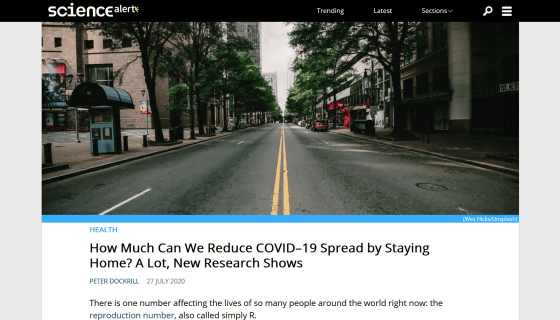To what extent can the outbreak of the new coronavirus be suppressed by keeping a social distance by refraining from going out unnecessarily?

It is said that it is important to reduce contact with people as much as possible and live a social distance in order to prevent infection with the new coronavirus. The results of an analysis based on smartphone location data on how much the new coronavirus epidemic can be suppressed by actually maintaining a social distance were reported to the medical journal
Association of Social Distancing, Population Density, and Temperature With the Instantaneous Reproduction Number of SARS-CoV-2 in Counties Across the United States | Infectious Diseases | JAMA Network Open | JAMA Network
https://jamanetwork.com/journals/jamanetworkopen/fullarticle/2768570
Study Confirms Social Distancing as Most Effective Intervention Against COVID-19 | PolicyLab
https://policylab.chop.edu/press-releases/study-confirms-social-distancing-most-effective-intervention-against-covid-19
How Much Can We Reduce COVID–19 Spread by Staying Home? A Lot, New Research Shows
https://www.sciencealert.com/how-much-can-we-reduce-covid-19-spread-by-staying-at-home-a-lot-new-research-shows

The '
A policy of keeping a social distance with others is considered effective for lowering the R0 value, but it is difficult to experience how effective it is to actually make a social distance. So, a research team led by Professor David Rubin of the University of Pennsylvania School of Medicine investigates factors related to epidemic control of the new coronavirus in 211 counties covering 54% of the total population of the United States across the states I went to.
The research team has been working for about two months from February 25 to April 23, 2020 for about two months to provide data on the movement of people based on location information, such as smartphone location information obtained from Unacast and temperature during the period, Collect data such as population density in the target area. By collating this data with data on the infection status of the new coronavirus, we investigated which factors have the greatest effect on the R0 value. In addition to social distance, population density is also expected to be closely related to epidemics such as viruses, and if temperature affects the epidemic of new coronavirus, such as 'the epidemic of new coronavirus will end in summer'. There is also an opinion.

Based on the location data of the smartphone, the research team measures 'visiting non-essential shops such as restaurants and beauty salons' and compares the frequency of visits during and before the pandemic. We investigated how people responded to social distance policies after the pandemic.
As a result, on average, a correlation was found that '50% reduction in non-essential visits reduces the R0 value by 46%, and 75% decrease in non-essential visits reduces the R0 value by 60%.' Also, the high population density was associated with a slight increase in the R0 value. On the other hand, although the temperature that was neither too cold nor too hot was associated with a decrease in the R0 value, the relationship between the temperature and the R0 value was somewhat unclear, the research team says.
Although this study derives a correlation from the observed results, it can be said that maintaining social distance supports the speculation that it helps prevent the epidemic of the new coronavirus. Rubin pointed out that the results could have reduced the number of cases as in Europe and Canada if the United States continued its strategy of maintaining longer social distances. He argued that a nationally worn social mask should be used to control future infections.

Related Posts:
in Science, Posted by log1h_ik







